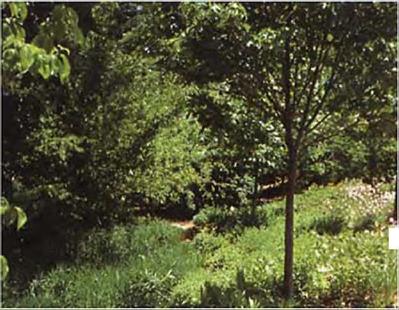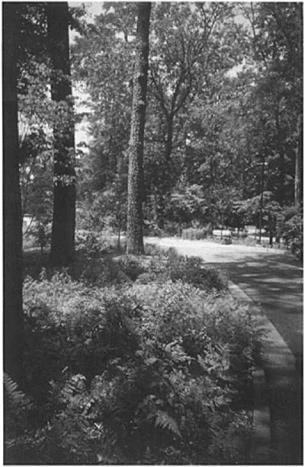On the open slope along the east fapade of the museum building, an early successional Piedmont forest is dominated by closely-spaced loblolly pines of various sizes. On the front, the pines grade into a woodland edge of sassafras, sumac and plum. As native hardwood species invade this zone, they will be permitted to develop as they do in a naturally evolving successional forest. Consequently, the scene will change: the pines will become more lofty, with sourwood, dogwood, redbud and other deciduous tree species forming a sub-canopy beneath them (Figures 5.4 and 5.5).
Hardwood forest
In the areas to the north of the Museum building, where there was a partial canopy of tall pine and oak trees, a Piedmont hardwood forest is being reestablished, including white oak, hickory, red maple, blackgum and ‘drifts’ of American beech. Smaller trees, such as serviceberry, flowering dogwood and redbud provide colour and spatial variation at the midstory level, as do the shrubs, such as sparkleberry, sweetshrub and maple-leaf viburnum.
The herbaceous layer was designed in stylised, curving swaths of different species mixes, matched with different light levels that result from building shadows and from both the pre-existing and newly planted canopy trees. In semi-shaded areas, for example, a mix of bracken fern, columbine, firepink, bluestar and blue-eyed grass is planted (Figure 5.6).
|
|
5.6
Upland ground-layer planting for semi-shaded zone, including bracken fern (Pteridium aquilinum), columbine (Aquilegia canadensis) and bluestar (Amsonia
tabernaemontana), Atlanta History Center (spring 1996)
In deeper shade, the evergreen Christmas fern is interplanted with woods phlox and wild geranium. Other mixes occupy other swaths; oakleaf-mulched zones occur between the planted zones with the expectation that certain of the planted herbaceous species will migrate into these areas.
In summary, in the hardwood forest planting, a framework of woody plants was established, and it is reflected in the layout of a stylised ground layer pattern. It is expected that there will be change in this landscape, brought about both by the growth and spread of initially planted vegetation, and by other species that may colonise. Management in this zone mainly consists of suppressing invasive exotic plant species that appear.
|
|
5.7
Drifts of ragwort (Senecio aureus) and river oats (Chasmanthium latifolium) in drainage swale, Atlanta History Center (March 1995)

5.8
Drifts of ragwort (Senecio aureus) and river oats (Chasmanthium latifolium) in drainage swale, Atlanta History Center (September 1994)
|
|
5.9
River oats (Chasmanthium latifolium) and sensitive fern (Onoclea sensibilis) at the edge of a drainage swale, Atlanta History Center (spring 1995)




